Introduction
After extraction from sugar cane or sugar beets, the juice must be purified to remove the many other organics and minerals that accompany it.
The processing to accomplish this is heavily dependent on reliable pH measurement and control as illustrated.
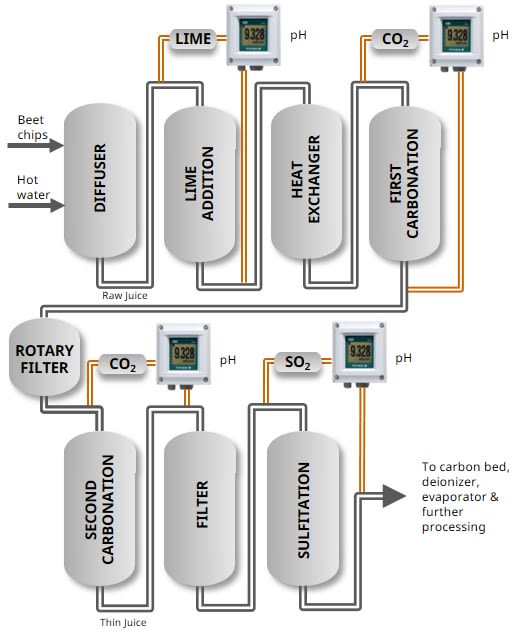
The process for refining raw sugar cane or sugar beets includes the following steps:
- Washing
- Crushing
- Extraction
- Liming - critical
- Carbonation - critical
- Filtering
- Addition of sulfur dioxide - critical
- Concentrating
- Crystallizing
- Drying
Each of the critical steps requires continuous pH control.
Lime Addition
After thoroughly washing the sugar cane or beets they are crushed or cut into chips and placed in a hot water in a diffuser to extract the sugar. The resulting "raw juice" is treated with alkaline ‘milk of lime’ (calcium hydroxide (CaOH) slurry), based on pH controlling to a set point of 11.0 to 11.5 pH.
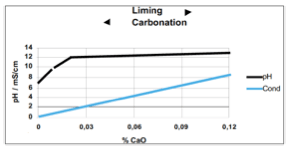
The purpose of adding lime is threefold:
- Neutralize acids in the cane of beets, thereby preventing the sucrose from turning into starch (hydrolysis) or other forms of sugar (inversion).
- Precipitate the organic acids into salts for subsequent removal.
- Keeping foreign matter (insoluble organics, proteins, etc.) in suspension until a filtration process can remove them.
Carbonation
All traces of lime must be removed before the concentration step to prevent scale buildup.
Carbon dioxide is added to the juice to precipitate the lime as less soluble calcium carbonate (limestone), which can capture other impurities during precipitation. CaO + CO2 = CaCO3 (solid).
The sugar solution is heated and carbon dioxide is added by the pH control. Optimum purification is achieved through two stages of carbonation to avoid an unmanageable type of precipitate that can develop in single-stage carbonation. Close pH control is necessary at each stage to assure maximum removal of both impurities and calcium. By the last stage, the pH should be reduced to about 9.
After carbonation, the juice is filtered to remove all traces of solid particles before being transported to the sulfitation tower.
Addition of Sulfur Dioxide (Sulfitation)
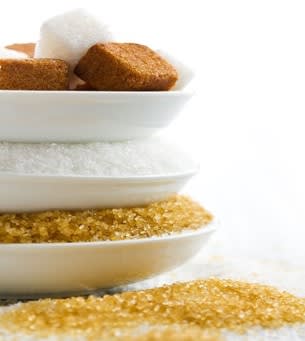 The juice is maintained at high temperatures and treated with sulfur dioxide to lower the pH to roughly 5-6 before it travels to the evaporators.
The juice is maintained at high temperatures and treated with sulfur dioxide to lower the pH to roughly 5-6 before it travels to the evaporators.
The sulfur dioxide also bleaches the juice to improve flavor and texture. Without this step, an alkaline juice would be produced. The sugar crystals would stick together due to moisture and have an undesirable taste. The sugar juice is then heated to drive off any residual gases and provide a neutral product (pH control is essential to create an efficient operation).
Further purification to remove the last traces of color and impurities may use carbon beds and ion exchange resins (Conductivity measurement is a key variable in monitoring the operation and regeneration of ion exchange beds).
The purified thin juice then moves on to multi-effect evaporators for concentration, vacuum pans for crystallization, centrifugal separators, and dryers.
Challenges
pH sensors must stand up to severe process conditions during the liming and carbonation stages, to provide a consistent measurement. Examples include:
- CaCO3 precipitates on every surface including probes.
- Carbonators operate at 95°C
- Sugar juice temperature compensation curves do not conform to standard temperature correction curves
- Sugar juice contains Sulfur dioxide that reacts with typical reference probes
- Environmental conditions are wet, hot, and corrosive
Solutions
Analyzer
The Yokogawa FLXA402 has an automatic sensor washing function, self-diagnostics, and custom temperature compensation. Besides the cleaning function, the sensor washing cycle also provides an online response test, giving an immediate indication of sensor deterioration.
Sensors
In the past, mainly single electrodes were used. Installation was done in the bypass together with a chemical cleaning system. To prevent the reference sensor from clogging and poisoning a flowing type reference sensor, like the well-known Bellomatic electrode, was preferred. A pH-electrode is a heavy-duty glass electrode designed to withstand certain chemicals and high temperatures.
Today Yokogawa’s combined pH- sensors such as SC25, FU20, and FU24 are fulfilling these demands and are used successfully in this application. If the sensors are cleaned regularly with diluted acids they will offer a long service life. The cleaning frequency will depend on the application. By using an automatic retractable cleaning system (e.g. EXAtrac) even a direct process installation is possible.
The transmitter stores the calibration data and if the asymmetry potential exceeds 50 mV and the slope drops below 80%, then replacement must be considered.
Product Recommendations
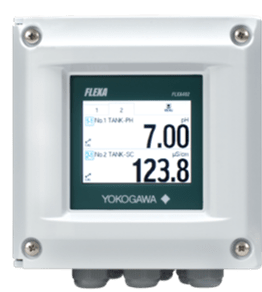 Process Liquid Analyzer:
Process Liquid Analyzer:
4-wire AC or DC FLXA402 Analyzer – pH/ORP measurement system
Sensor/Fitting Selection:
Option #1: Bypass Installation
- SC25, FU20/FU24 pH/ORP combination electrode
- FF20 flow-thru assembly with a cleaning nozzle
 Alternatively, Digital Smart sensors can be used. SENCOM technology, which allows sensors to transmit and receive data when connected to a transmitter/analyzer or any PC. The SMART digital sensors maintain specific measurement and calibration data on an integrated chip that is an integral part of the sensor providing easy plug-and-play solutions. Data management software to optimize the performance of sensors for enhanced reliability and process safety.
Alternatively, Digital Smart sensors can be used. SENCOM technology, which allows sensors to transmit and receive data when connected to a transmitter/analyzer or any PC. The SMART digital sensors maintain specific measurement and calibration data on an integrated chip that is an integral part of the sensor providing easy plug-and-play solutions. Data management software to optimize the performance of sensors for enhanced reliability and process safety.
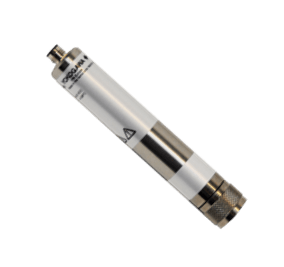 Digital SMART Option:
Digital SMART Option:
The re-usable smart adapter, SA11, offers full measuring parameter functionality of analog sensors equipped with a Variopin connector and Yokogawa ID chip. The SA11 automatically recognizes the installed sensor and prepares the right configuration.
Option #2: Direct process installation
- SC25 pH-combined electrode
- EXAtrac (RF20H) automatic retractable fitting with an automatic cleaning system

Industries
-
Chemical
Chemical plants rely on continuous and batch production processes, each posing different requirements for a control system. A continuous process calls for a robust and stable control system that will not fail and cause the shutdown of a production line, whereas the emphasis with a batch process is on having a control system that allows great flexibility in making adjustments to formulas, procedures, and the like. Both kinds of systems need to be managed in available quality history of product, and to be able to execute non-routine operations. With its extensive product portfolio, experienced systems engineers, and global sales and service network, Yokogawa has a solution for every plant process.
-
Food & Beverage
The food and beverage industry must produce safe, high-quality foods and beverages for consumers. In addition to quality control, the manufacturing processes include many challenges such as managing ingredients, improving efficiency and handling global environmental issues. Yokogawa leverages its decades of technological expertise to help customers build and operate the ideal factory.
Related Products & Solutions
-
12mm pH Sensor SC25V
The SC25V is a pH sensor in a 12 mm design that includes an integral temperature element and a Liquid earth electrode.
-
All-in-One pH/ORP Sensor Series FU20 and FU24
The FU20 and FU24, all-in-one pH and ORP, sensors show how Yokogawa applies the motto "Simple is best" to sensor technology.
-
Digital SMART SENCOM™ Adapter, SA11
Reusable SMART adapter, requiring only the analog sensor to be disposed of when it reaches the end of its lifetime. With the SENCOM 4.0 platform, Yokogawa delivers reduced costs and waste while contributing to its long-term business goals of a sustainable future for all.
-
Multi Channel 4-Wire Analyzer FLXA402
The FLEXA™ series analyzers are modular-designed analyzers used for continuous online measurements in industrial installations. They offer single or multi-sensor measurement.
-
Liquid Analyzers
- Liquid analyzers
- Monitoring process chemistry
- Water quality
- Process optimization and control
-
pH and ORP Analyzers
pH and ORP meters, analyzers and transmitters are used for continuous process monitoring of pH and ORP to ensure water/product quality, monitor effluent discharge, batch neutralization, pulp stock, scrubbers, cooling towers, chemical, water/wastewater treatment and many other applications.
Have Questions?
Contact a Yokogawa Expert to learn how we can help you solve your challenges.